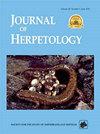Thirteen Years of Turtle Capture–Mark–Recapture in a Small Urban Pond Complex in Louisiana, USA
IF 0.8
4区 生物学
Q3 ZOOLOGY
引用次数: 0
Abstract
Abstract. Turtles are one of the most imperiled vertebrate groups in the world. With habitat destruction unabated in many places, urban and suburban greenspaces may serve as refugia for turtles, at least those species able to tolerate heavily altered landscapes. In south-central Louisiana, we have conducted a turtle capture–mark–recapture effort in two ponds in an urban greenspace for 13 yr to understand species composition, survival, and individual growth rates. We had 574 total captures of 251 individuals of five species from 2009–2021, with Trachemys scripta elegans (Red-Eared Sliders) and Sternotherus odoratus (Eastern Musk Turtles) being the most common. Apparent annual survival for T. scripta (0.79) was similar to estimates reported in other studies in altered habitats, whereas apparent annual survival for S. odoratus (0.89) was slightly or much higher than other published studies. Growth rates of T. scripta were comparable to other studies and showed both sexes have similar rates of growth until maturity, which is earlier and at a smaller size in males. The two ponds showed marked differences in captures by size, with significantly more juvenile T. scripta captured in the pond with more vegetation, depth, and a softer bottom. Most T. scripta (78.5%) that were recaptured came from the same pond from which they were originally captured. The basic demographic data gained in this study can serve as a starting point for broader questions on urbanization effects and as a comparison to more natural populations.在美国路易斯安那州一个小型城市池塘群中开展海龟捕捉-标记-再捕捉活动 13 年
摘要海龟是世界上最濒危的脊椎动物之一。由于许多地方的栖息地破坏有增无减,城市和郊区的绿地可能成为海龟的避难所,至少是那些能够忍受严重景观改变的物种。在路易斯安那州中南部,我们在城市绿地的两个池塘中进行了长达 13 年的海龟捕捉-标记-再捕捉工作,以了解物种组成、存活率和个体生长率。从 2009 年到 2021 年,我们共捕获了 574 次,捕获了 5 个物种的 251 只个体,其中最常见的是红耳滑龟(Trachemys scripta elegans)和东方麝香龟(Sternotherus odoratus)。T.scripta的表观年存活率(0.79)与其他研究报告的在改变生境中的估计值相似,而S. odoratus的表观年存活率(0.89)略高于或远高于其他已发表的研究报告。T.scripta的生长率与其他研究结果相当,表明雌雄T.scripta在成熟前的生长率相似,但雄性T.scripta成熟较早且体型较小。两个池塘的捕获量在大小上存在明显差异,在植被较多、水深较深且池底较软的池塘中捕获的金眼蟾幼体明显较多。重新捕获的大多数(78.5%)T. scripta 来自最初捕获它们的同一个池塘。本研究获得的基本人口统计学数据可作为一个起点,用于探讨城市化影响的更广泛问题,并与更自然的种群进行比较。
本文章由计算机程序翻译,如有差异,请以英文原文为准。
求助全文
约1分钟内获得全文
求助全文
来源期刊

Journal of Herpetology
生物-动物学
CiteScore
1.60
自引率
0.00%
发文量
45
审稿时长
6 months
期刊介绍:
The Journal of Herpetology accepts manuscripts on all aspects on the biology of amphibians and reptiles including their behavior, conservation, ecology, morphology, physiology, and systematics, as well as herpetological education. We encourage authors to submit manuscripts that are data-driven and rigorous tests of hypotheses, or provide thorough descriptions of novel taxa (living or fossil). Topics may address theoretical issues in a thoughtful, quantitative way. Reviews and policy papers that provide new insight on the herpetological sciences are also welcome, but they must be more than simple literature reviews. These papers must have a central focus that propose a new argument for understanding a concept or a new approach for answering a question or solving a problem. Focus sections that combine papers on related topics are normally determined by the Editors. Publication in the Long-Term Perspectives section is by invitation only. Papers on captive breeding, new techniques or sampling methods, anecdotal or isolated natural history observations, geographic range extensions, and essays should be submitted to our sister journal, Herpetological Review.
 求助内容:
求助内容: 应助结果提醒方式:
应助结果提醒方式:


